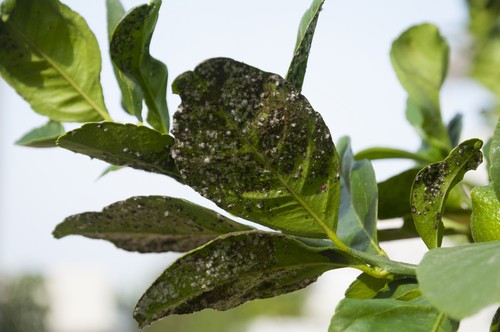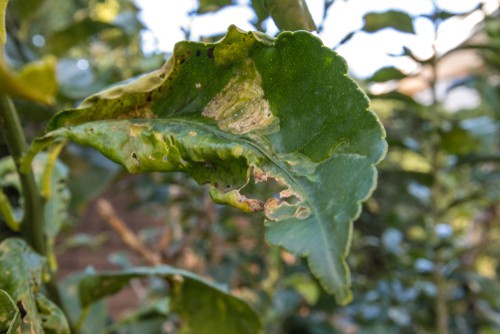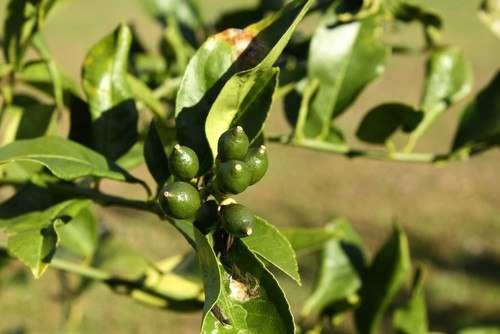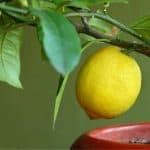Last updated on March 30th, 2022
Our site is reader supported, this means we may earn a small commission from Amazon and other affiliates when you buy through links on our site.
Citrus trees make bright, delightful additions to any indoor or outdoor space. They also give you a steady supply of citrus fruits for whatever desserts you want to make. Growing citrus trees in pots are one of the most successful ways to enjoy these warm-weather loving trees in a cold-weather environment.
However, if you have worked hard to plant and maintain your citrus trees and now you notice the leaves are starting to curl, it’s time for some intervention. Curled leaves can indicate a serious problem of environmental issues.
See our article on citrus trees problems in this guide by clicking here
What causes the leaves to curl on a citrus tree?
When the leaves curl on your citrus tree, it could be caused by environmental issues or by pests. No matter the cause, curling leaves are an indication of a problem. Below are the most common causes and how you can manage them.
Pests that cause curled leaves in citrus

Aphids & Mites
Pests like mites and aphids suck out the sap from the leaves of the citrus. They extract the juices from the tissues inside the leaves. And as the population of pests grow, they cause deformation and discolouration. The most prominent distortion is curling leaves. You might notice that the leaves are just starting to curl, and if you check the underside, you will see the tiny pests feeding in groups.
As soon as you see pests, spray them with insecticidal soap or pesticide especially for fruit and be sure to coat the entire leaf. This should be a process you repeat every 2 weeks until your plant recovers, and there are no remaining signs of any pest problems.

Citrus leaf miner
Citrus leaf miners are another serious pest problem that, as the name suggests, only affects citrus leaves. They work very similarly, but instead of sucking out the juices from the leaves, they tunnel through the leaf tissues. You will see the signs of this pest in the form of white or yellow lines along your otherwise green leaf surface. The problem with Citrus Leaf miners is that they’re difficult to treat.
Some people suggest that you let them run their course because most citrus plants can tolerate a pretty heavy bout of Citrus Leaf Miners and they very rarely will kill the plant, other people suggest you throw out the plant entirely and start over. You can also try spraying with a pesticide such as Provado Ultimate Bug Killer.
- Kills most common insect pests on a comprehensive range of fruit and vegetable plants such as apples and pears.
- Contact insecticide that can protect from pests for up to 2 weeks.
- Ideal for Grow your own.
- Kills and controls greenfly, blackfly, caterpillars, beetles, weevils, apple & pear suckers, capsids, sawfly, whitefly.
Environmental Issues

Lack of water
Another cause of citrus leaves curling is environmental. Drought stress is the most common cause and you should count yourself lucky if it’s your cause because it’s also the easiest to treat. If your leaves are starting to curl inwards, but the leaves and the soil around the tree is very dry, it just means you aren’t watering your plants enough.
You can apply extra mulch around the base and increase your watering. Hold off on fertilising your tree until it resumes healthy leaf production. We recommend watering frequently in summer but wait for the surface of the soil to dry before watering again. Allow the water to drain through into a saucer but don’t leave the pot sitting in water because this can lead to overwatering.
Potassium deficiency
One other environmental issue is that of a potassium deficiency. If your leaves are curling, they are bent downwards at the tip, and they have a yellow hue, it could mean they lack potassium. Check the pH and nutrient levels to make sure this is the problem and once that’s confirmed, add some fertiliser with extra potassium.
Be sure to water when you add the fertiliser so that the potassium can move through the root structure. Usually using a winter or summer feed is enough to resolve this issue.
- HIGH NITROGEN CONTENT TO SUPPORT GROWTH AND IMPROVE FRUITING: Vitax Summer Citrus Feed ensures robust plant development and enhances the quality and quantity of citrus fruits like lemons, kumquats, and limes. "
- DISCOURAGES PREMATURE RIPENING, FRUIT DROP, AND LEAF DISCOLOURATION: Helps maintain healthy and vibrant plants by preventing common issues that affect citrus plants.
- APPLY WEEKLY FROM APRIL TO SEPTEMBER: Provides a consistent and tailored feeding schedule to meet the nutritional needs of citrus plants during their peak growing season.
- IDEAL FOR PLANTS GROWING IN POTS OUTDOORS IN SUMMER AND INDOORS IN WINTER: Allows for flexible cultivation of citrus plants, ensuring they receive the necessary care and environment throughout the year.
- SUITABLE FOR VARYING CONDITIONS: Vitax Summer Citrus feed is suitable for citrus requiring differing climate conditions, making it a great choice for hardier lemons as well as those requiring warmer year round conditions
- HELPS PREVENT PREMATURE LEAF FALL AND DISCOLOURATION: Vitax Winter Citrus Feed ensures citrus plants remain healthy and vibrant during the colder months, supporting their overall vitality.
- CAREFULLY BALANCED TO MAINTAIN GROWTH: Provides essential nutrients to sustain citrus plant growth and prepare them for fruiting in the summer.
- APPLIED MONTHLY BETWEEN OCTOBER AND MARCH: Vitax Winter Citrus Feed offers a consistent feeding schedule tailored for the autumn and winter seasons to meet the specific needs of citrus plants.
- IDEAL FOR INDOOR USE DURING COLDER MONTHS: Citrus plants should be moved indoors to a warm, humid environment such as a greenhouse or conservatory to thrive during the winter, Vitax Winter Citrus Feed supports with this.
- EASY TO USE AND STORE: Mix with water as instructed and apply when the compost has dried out. Store in a cool, dry place and always read the label before applying.
Cold temperatures
If your citrus tree is exposed to the cold it can cause the leaves to start to curl and maybe droop a little. This is usually a problem in winter when moved indoors into a room that is too cold or exposed to cold drafts from open doors. Learn more about overwintering citrus trees in this guide.
Overall, the best way to prevent curled leaves on your citrus tree is to water regularly so that it doesn’t have to contend with drought, but also avoid over-watering. Periodically check the pH levels to ensure that the soil is providing adequate nutrients. And finally, be on the lookout for pests and deal with them as soon as you see them.
Image credits – Shutterstock.com
Last update on 2025-07-02 / Affiliate links / Images from Amazon Product Advertising API





